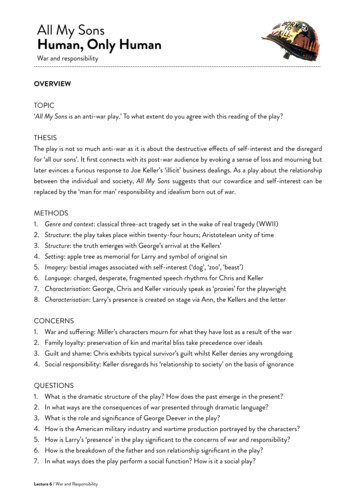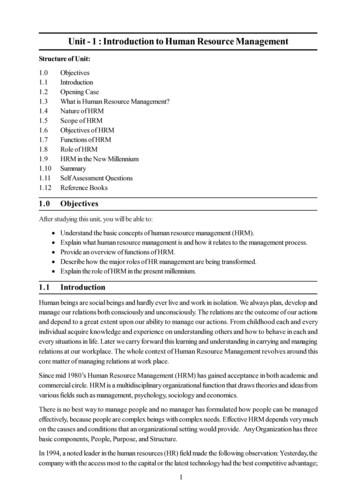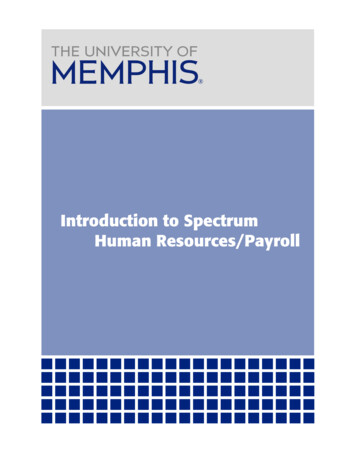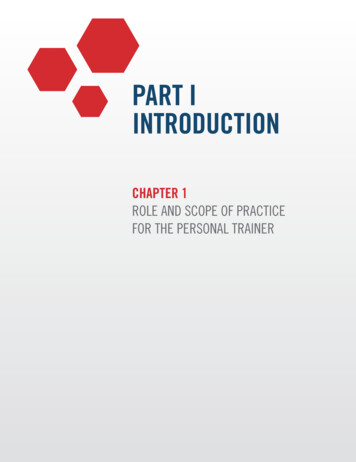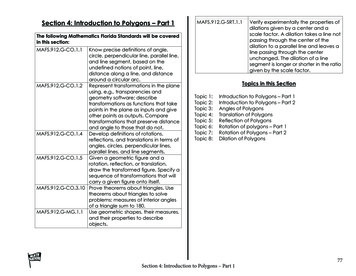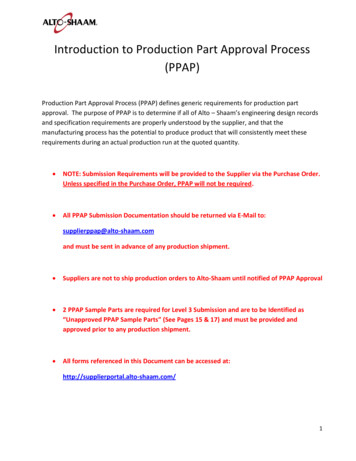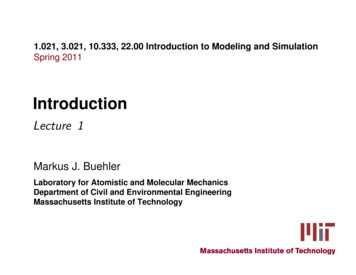
Transcription
PART I Introduction toHuman ResourceManagement andHuman ResourceInformation Systems
1 Evolution ofHuman ResourceManagement andHuman ResourceInformationSystemsThe Role of Information TechnologyMohan ThiteMichael J. KavanaghEDITORS’ NOTEThe purpose of this chapter is to provide an introduction to the fields of humanresource management (HRM) and information technology (IT), and the combination of these two fields into human resource information systems(HRIS). The first chapter will lay the groundwork for the remainder of this book,3
4 INTRODUCTION TO HRM AND HRISand as such, it is important to thoroughly understand the concepts and ideas in thischapter.This chapter contains definitions for a number of terms in common use inthe HRM, IT, and HRIS fields and will emphasize the major underlying themes ofthis book. Finally, an overview of the entire book will be covered, showing howeach chapter is an integral part of the entire field of HRIS.CHAPTER OBJECTIVESAfter completing this chapter, you should be able to Describe the historical evolution of HRM, including the changing role of thehuman resources (HR) professional Discuss the impact of computer technology on the evolution of HRM Describe the three types of HR activities Explain the relationship between strategic HRM and HRIS Explain the purpose and nature of HRIS as well as the differences betweenthe types of HRIS Discuss the use of information from an HRIS in decision making Describe the central themes of the book and how they relate to manager-ial decision making Understand how HRM and HRIS fit into a comprehensive model of orga-nizational functioningVIGNETTEThere are numerous federal and state laws and regulations regarding the treatment ofemployees, as will be discussed throughout this book. For example, some of these lawsregulate the number of working hours in a week and overtime requirements, unionmanagement relations, and unfair discrimination in the personnel practices of a firm. Onesuch law, Title VII of the Civil Rights Law of 1964 as amended by the Equal OpportunityAct of 1972, protects individuals against unfair discrimination based on race, national origin, and gender in any personnel decision—for example, hiring. This law protecting therights of individuals is generally referred to as Equal Employment Oppor tunity (EEO) legislation. To determine if organizations are complying with this law, all U.S. companies mustcomplete an annual report for the federal government, called the EEO-1 report. This reportdescribes the composition of the work force by job in terms of gender, race, and nationalorigin (see Chapter 9). This report is often referred to as an EEO or Affirmative ActionAudit. The important point is that the employees must be categorized into jobs, and then
Chapter 1 Evolution of HRM and HRIS 5the number and percentage distributions of racial, gender, and national origin of employees must be determined.A regional distributor and service center for a national appliance company with300 employees had to complete all annual government reports on employees for the previous year by January 31. All the employee records were in paper files. The Director ofHuman Resources indicated that the compliance with the EEO laws in terms of completing the EEO-1 report took one full-time HR employee working for 1 month to completethe report. The lengthy time taken to complete the report was due to the fact that theemployee records had to be searched each year since there were new hiring, promotions,terminations, and other turnover during the year. After this company acquired HRIS software for all government reports, it only took about 4 hours to complete the EEO-1 report.This company example illustrates one important advantage of conversion to anHRIS from a paper-based system—reduction of staff time on reports. It should be noted,however, that accuracy of reports is still a concern, and accuracy of employee records isdetermined mainly from the correct inputting of employee data for the softwareprograms. It is also important to note that the cost savings of reducing staff time togenerate the report is not the only benefit from adoption of computer-based HR software. As will be discussed later in this chapter, the time saving means that the HR professional can be assigned to other, more important tasks for the company. Thesecharacteristics of an HRIS—speed and accuracy—will be emphasized throughout thisbook as the major advantage of an HRIS.IntroductionLeading management thinkers suggest that “it is not technology, but the art of humanand humane-management” that is the continuing challenge for executives in the21st century (Drucker, Dyson, Handy, Saffo, & Senge, 1997). Similarly, Smith and Kelly(1997) believe that “future economic and strategic advantage will rest with the organizations that can most effectively attract, develop and retain a diverse group of thebest and the brightest human talent in the market place” (p. 200).In general, to maintain a competitive advantage in the marketplace, firms need tobalance the resources available to the firm to achieve the desired results of profitability and survival. The resources that are available to the firm fall into three generalcategories: physical, organizational, and human. In discussing how to gain a competitive advantage in the global market, Porter (1990) noted that management of thehuman resources is the most critical of the three. The idea of treating human resourcesas a means of gaining a competitive advantage in both the domestic and the globalmarketplace has been echoed by other authors. As Greer (1995) states,In a growing number of organizations human resources are now viewed as a source ofcompetitive advantage. There is greater recognition that distinctive competencies areobtained through highly developed employee skills, distinctive organizational cultures,
6 INTRODUCTION TO HRM AND HRISmanagement processes, and systems. This is in contrast to the traditional emphasis ontransferable resources such as equipment. . . . Increasingly, it is being recognized that competitive advantage can be obtained with a high quality work force that enables organizations to compete on the basis of market responsiveness, product and service quality,differentiated products, and technological innovation. (p. 105)The effective management of human resources in a firm to gain a competitiveadvantage in the marketplace requires timely and accurate information on currentemployees and potential employees in the labor market. With the evolution of computer technology, meeting this information requirement has been greatly enhancedthrough the creation of HRIS. A basic assumption behind this book is that the management of employee information will be the critical process that helps a firm maximizethe use of its human resources and maintain competitiveness in its market.The first purpose of this book is to provide information on the development, implementation, and maintenance of an HRIS. The second purpose is to demonstrate how anHRIS can be used in HRM programs, such as selecting and training employees, to makethem more efficient and effective. The final purpose is to provide an opportunity for youto apply your knowledge through the analysis of the cases at the end of each chapter.Historical Evolution of HRM and HRISOne can analyze the historical trends of the HR function from different viewpoints:the evolution of HRM as a professional and scientific discipline, as an aid to management, as a political and economic conflict between management and employees, andas a growing movement of employee involvement influenced by developments inindustrial/organizational and social psychology. This historical analysis will demonstrate the growing importance of employees from being just one of the means of production in the 20th-century industrial economy to being a key source of sustainablecompetitive advantage in the 21st-century knowledge economy.Since this is a book on HRIS, we will examine the development of the fields ofboth HR and IT in terms of their evolution since the early 20th century. This meansexamining the evolution of HRM intertwined with developments in IT and describinghow IT has played an increasing role in the HRM function. In addition, this historicalanalysis will show how the role of HRM in the firm has changed over time fromprimarily being concerned with routine transactional HR activities to dealing withcomplex transformational ones. Transactional activities are the routine bookkeepingtasks—for example, changing an employee’s home address or health care provider—whereas transformational activities are those actions of an organization that “addvalue” to the consumption of the firm’s product or service. An example of a transformational HR activity would be a training program for retail clerks to improve customer service behavior. Thus, transformational activities increase the strategicimportance and visibility of the HR function in the firm. This general change overtime is illustrated in Figure 1.1 and will become evident as we trace the historical evolution of HRM in terms of five broad phases of the historical development of industry in the United States. For more information on this historical development, youshould consult Kavanagh, Gueutal, and Tannenbaum (1990) or Walker (1982).
Chapter 1 Evolution of HRM and HRIS 7 Figure 1.1 Historical Evolution of HRMRole of HRMEarly 20th Century21st CenturyCaretakerStrategic partnerEmployee focusRecordsCost effectivenessEmployee developmentPre–World War IIIn the early 20th century and prior to World War II, the personnel function (the precursor of the term human resource management) was primarily involved in record keeping of employee information; in other words, it fulfilled a “caretaker” function. Duringthis period of time, the prevailing management philosophy was called “scientific management.” The central thrust of scientific management was to maximize employee productivity. It was thought that there was one best way to do any work, and this best waywas determined through time and motion studies that determined the most efficientuse of human capabilities in the production process. Then, the work could be dividedinto pieces, and the number of tasks to be completed by a worker during an averageworkday could be computed. These findings formed the basis of piece-rate pay systems,which were seen as the most efficient way to motivate employees.At this point in history, there were very few government influences in employmentrelations, and thus, employment terms, practices, and conditions were left to the owners of the firm. As a result, employee abuses such as child labor and unsafe workingconditions were common. Some employers set up labor welfare and administrationdepartments to look after the interests of workers by maintaining records on healthand safety as well as recording hours worked and payroll. It is interesting to note thatrecord keeping is one of the major functions built into the design of an HRIS today;however, there was simply no computer technology to automate the records at thistime in history. Of course, paper records were kept, and we can still see paper recordHR systems in many smaller firms today.Post–World War II (1945–1960)The mobilization and utilization of labor during the War had a great impact on thedevelopment of the personnel function. Managers realized that employee productivity and motivation had a significant impact on the profitability of the firm. The humanrelations movement after the War emphasized that employees were motivated not justby money but also by social and psychological factors, such as recognition of workachievements and work norms.
8 INTRODUCTION TO HRM AND HRISDue to the need for classification of large numbers of individuals in military serviceduring the war, systematic efforts began to classify workers around occupational categories in order to improve recruitment and selection procedures. The central aspect ofthese classification systems was the job description, which listed the tasks, duties, andresponsibilities of any individual who held the job in question. These job descriptionclassification systems could also be used to design appropriate compensation programs,evaluate individual employee performance, and provide a basis for termination.Because of the abusive worker practices prior to the War, employees started forming trade unions, which played an important role in bargaining for better employmentterms and conditions. There were a significant number of employment laws enactedthat allowed the establishment of labor unions and defined their scope in relationshipwith management. Thus, personnel departments had to assume considerably morerecord keeping and reporting to governmental agencies. Because of these trends, thepersonnel department had to establish specialist divisions, such as recruitment, laborrelations, training and benefits, and government relations.With its changing and expanding role, personnel departments started keepingincreasing numbers and types of employee records, and computer technology began toemerge as a possible way to store and retrieve employee information. In some cases inthe defense industry, job analysis and classification data were inputted into computersto better understand, plan, and use employee skills against needs. For example, the U.S.Air Force conducted a thorough and systematic job analysis and classification throughits Air Force Human Resources Laboratory (AFHRL), which resulted in a comprehensive occupational structure. The AFHRL collected data from thousands of airmen injobs within the Air Force, and through the use of a computer software program calledthe Comprehensive Occupational Data Analysis Program (CODAP), it was able tomore accurately establish a job description classification system for Air Force jobs.Personnel departments outside the defense industry were no
Human Resource Management and Human Resource Information Systems The Role of Information Technology Mohan Thite Michael J. Kavanagh EDITORS’ NOTE The purpose of this chapter is to provide an introduction to the fields of human resource management (HRM) and information technology (IT), and the com - bination of these two fields into human resource information systems (HRIS). The first

